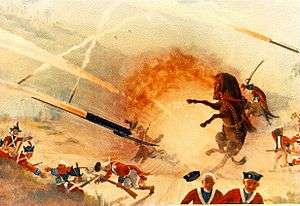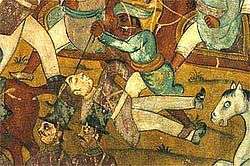Battle of Pollilur (1780)
| ||||||||||||||||||||||||||||||
The Battle of Pollilur, also known as the Battle of Polilore or Battle of Perambakam, took place on 10 September 1780 at Pollilur near the city of Kanchipuram in present-day Tamil Nadu state, India as part of the Second Anglo-Mysore War. It was waged between two forces commanded by Tipu Sultan of the Kingdom of Mysore, and Colonel William Baille of the British East India Company. The army of the East India Company surrendered and suffered a high number of casualties. It was the worst loss the British suffered on the subcontinent until Chillianwala.
Tipu prevented Col. Baillie, at Guntur, from joining Hector Munro at Canjeevaram, while Tipu's father Hyder continued the siege at Arcot. Of the 3853 British men under Baillie's command, only 50 officers and 200 men were taken prisoner after the "general massacre". Baillie was taken to Seringapatam.[5]
Aftermath

Baille and many of his officers were captured and taken to the Mysore capital at Srirangapattana. After British reinforcements from Calcutta arrived, Eyre Coote was able to stabilise the situation and counter-attack. A second battle was fought a year later in the same area where Coote defeated Haider Ali's forces.
Rockets
The Mysore rockets used during the battle were much more advanced than the British East India Company had previously seen, chiefly because of the use of iron tubes for holding the propellant; this enabled higher thrust and longer range for the missile (up to 2 km range). After Tipu Sultan's eventual defeat in the Fourth Anglo-Mysore War and the capture of the Mysore iron rockets, they were influential in British rocket development, inspiring the Congreve rocket, which was soon put into use in the Napoleonic Wars.[6]
See also
References
- ↑ Gott, Richard (2000). Britain's Empire: Resistance, Repression and Revolt. London: Verso Books. p. 76. ISBN 1-84467-738-9. Retrieved 8 February 2012.
- 1 2 Dalrymple, William (1 October 2005). "ASSIMILATION AND TRANSCULTURATION IN EIGHTEENTH-CENTURY INDIA: A Response to Pankaj Mishra". Common Knowledge. 11 (3): 445–485. doi:10.1215/0961754X-11-3-445. Retrieved 8 February 2012.
As late as 1780, following the disastrous British defeat by Tipu Sultan of Mysore at the Battle of Pollilur, 7,000 British men, along with an unknown number of women, were held captive by Tipu in his sophisticated fortress of Seringapatam.
- ↑ Jaim, H M Iftekhar; Jaim, Jasmine (1 October 2011). "The Decisive Nature of the Indian War Rocket in the Anglo-Mysore Wars of the Eighteenth Century". Arms & Armour. 8 (2): 131–138. doi:10.1179/174962611X13097916223244. Retrieved 8 February 2012.
Captain Munro noted: 'Around two or three thousand horse and rocket-men kept hovering round our main army, in order to conceal his enterprise from us'.
- 1 2 Jasanoff, Maya (2005). Edge of empire: lives, culture, and conquest in the East, 1750-1850 (1. ed.). New York: Knopf. p. 157. ISBN 1-4000-4167-8.
Some three thousand Company soldiers were killed, while Baillie and two hundred Europeans, fifty of them officers, were carried off to Seringapatam in chains.
- ↑ Naravane, M.S. (2014). Battles of the Honorourable East India Company. A.P.H. Publishing Corporation. pp. 173–174. ISBN 9788131300343.
- ↑ Roddam Narasimha (1985). Rockets in Mysore and Britain, 1750-1850 A.D. National Aeronautical Laboratory and Indian Institute of Science.
Gallery
-
Baillie Dungeon, Seringapatam (2004)
-
Narrow Passage to Colonel Baillie's Dungeon, Seringapatam (2004)
-
Memorial Plaque at Baillie Dungeon, Seringapatam
-
Signboard at Baillie Dungeon, Seringapatam
-
Old Signboard at Baillie Dungeon, Seringapatam
-
Stones to which prisoners were tied to, Baillie Dungeon, Seringapatam
-
William Baillie Memorial, Seringapatam
-
Plaque of the William Baillie Memorial, Seringapatam
External links
- Tipu Sultan website
- Wilson, W. J. History of the Madras Army, Volume 2
